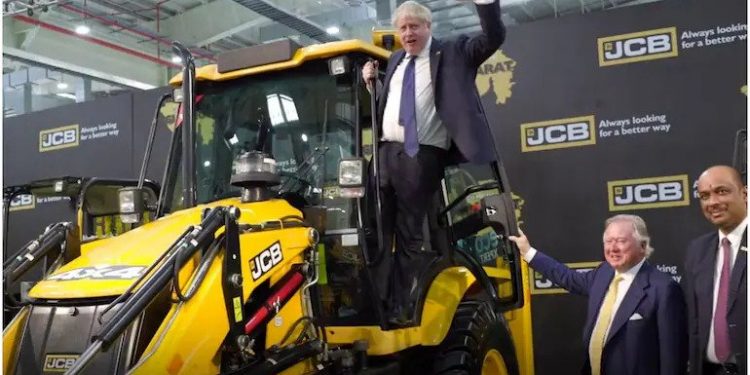The two-day visit to India by the British Prime Minister Boris Johnson late last week could be described more as an opportunity for him to escape the ‘heat’ of the probe into his Partygate scandal and rather bear the heat of summer in India. The probe into his (mis)deeds is fast gaining momentum in the UK. Johnson’s visit to India achieved very little for the two countries’ bilateral interests. Despite the various agreements and announcements of trade ties, the gains are not as substantial as is being made out. Reportedly, an understanding has been reached for which Indians, possibly, will have easier access to UK visas and whiskey. The recognition of India as a key partner in the West’s Indo-Pacific defence engagements does not have much to do with the British PM since India is only benefiting from its geopolitical position in this regard. In fact, Johnson’s visit was, from the very beginning, plagued by controversies after he went to attend the inauguration of a new JCB factory in Gujarat owned by a Tory donor, Anthony Bamford. The construction equipment major produces yellow colored bulldozers, some of which were photographed notoriously being used to demolish homes of minorities in Delhi recently. His theatrics over refusing to use a Russian made helicopter during his itinerary as a protest against Russia’s invasion of Ukraine were equally ineffectual.
Johnson’s attempt to use his India visit to hail the success of JCB was met with backlash. He arrived at a time when a fierce row rages in Delhi over the demolition of mainly Moslem settlements in an area of the capital that was hit by communal violence. TV footage on the demolition had shown JCB bulldozers being used to flatten properties. The Supreme Court has ordered suspension of the cleaning operations. Amnesty India also tweeted: “In the backdrop of Municipal Corporation of Delhi using JCB bulldozers to raze down shops of Muslims in north-west Delhi’s Jahangirpuri, UK Prime Minister’s inauguration of a JCB factory in Gujarat is not only ignorant but his silence on the incident is deafening.” During his visit to the new JCB factory, Johnson called it a “living, breathing incarnation of the umbilicus between the UK and India.”
He waxed eloquent on the factory’s production – 600,000 equipment a year and “exported to 110 countries with British technology.” He sought to soft-pedal the protest against the company with a rhetorical hyperbole saying he respected all opinions in India “with 1.35 billion people.” But, the truth about his real intent that could not be concealed is that he had received a 10,000 pound donation from the firm three days before giving a speech at its headquarters praising JCB’s business acumen in January 2019, when he was a backbencher. His official spokesperson also denied the visit had anything to do with the PM’s closeness to the factory owner. Defending Johnson, he said the factory was chosen because it was “a very good illustration of UK business, working with India and the Indian government to benefit both the UK and India.” This is mere diplomatic verbiage. This reminds of former UK PM Theresa May’s visit to India in November 2016. In an informal get together at the New Delhi residence of the British High Commissioner, PM May had also spoken eloquently and at length about the UK being connected with India through the JCB. This then seems to be the only important umbilicus between the two countries, apart from whiskey.
Another purpose of the visit was to try to convince India not to support Russia’s war with Ukraine in any form. The outcome was predictable. India’s position has been forged by its long-standing relations with Russia which supplies the maximum of the former’s defence hardware. For decades, India was the single largest importer of Russian military equipment. According to one estimate, nearly $36bn out of a total $54bn India spent on arms imports over the last 20 years, went to Russia. Only around $4bn was spent on military equipment from the US and a similar amount from Israel. About 85 per cent of India’s key weapons systems are of Russian make. All this makes India highly dependent on Russia for spare parts, maintenance and upgrades. On the other hand, India’s attempts to buy more sophisticated and advanced American defence technology was met with sanctions imposed by the Clinton administration in 1998, after India tested multiple nuclear weapons. This only proves the point that India has no option but to buy Russian military technology.
In truth, the gains from the visit were relatively modest. Johnson hailed the prospects for a free trade agreement, which the Indian government is indeed keen to press ahead with. Modi’s keenness may help speed up the process, but talks have been underway since January, after a shift in Indian policy. Interestingly, India has already signed deals with the UAE and Australia recently.
There are questions too about how open the UK would be to granting large number of visas to Indians. Johnson seems to be willing to welcome more high-skilled Indian immigrants as part of an agreement, reversing a longstanding UK stance. But, there are indications that he is open to “inter-company transfers” only that allow firms to bring in overseas staff.
Johnson spoke of cooperation on green technologies, including a memorandum of understanding on wind power. This is expected to see Indian and UK firms collaborating. There was also the customary announcement of new investment projects, though some of these were notably small, one creating just 15 jobs. Of course, Downing Street claimed the total number of jobs that will be created is 11,000.
In short, the Johnson show was more froth than substance.






































